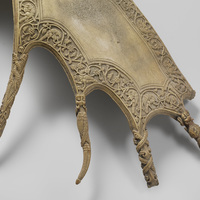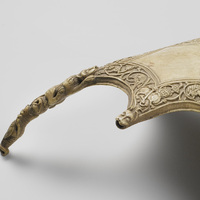Carved elk antler
Type:
Sculptures
Date:
Tenth to twelfth centuries
Location or Findspot (Modern-Day Country):
France
Dimensions:
79 × 52 cm
Description:
This unusual object is from the antler of an eight-point European elk. Some of the points, or tines, were broken, possibly during the animal's lifetime (bull elk shed their antlers every fall, growing new ones in the spring). Recent carbon-14 dating provides a date range of 975–1020 for the antler (that is, when it was shed or when the animal was killed). It was allegedly displayed in the funerary chapel of the Carolingian emperor Louis "the Pious" (d. 840) in the now lost church of Saint-Arnoul (a Merovingian bishop) in Metz. If so, it was placed there long after the death of Charlemagne's son and successor, because the carvings around the edge can be dated to the eleventh or twelfth century on stylistic grounds. Their closest comparisons come from the area around Metz, where the antler was first recorded in a local collection in the nineteenth century.
The carved vine-scroll border of the antler contains birds, lions, serpents, and hybrid creatures. The broken points terminate in lions' heads. By the time these carvings were executed, elk were rare in the area of Metz and on most of the European continent. The object might have been a hunting trophy (Louis "the Pious" was an avid hunter); displayed in a Carolingian royal chapel, it may have been considered a relic or an emblem of imperial power, perhaps with apotropaic value. Many objects from the natural world—narwhal tusks, ostrich eggs, fossils—were prized in the Middle Age and often given additional ornamentation.
The carved vine-scroll border of the antler contains birds, lions, serpents, and hybrid creatures. The broken points terminate in lions' heads. By the time these carvings were executed, elk were rare in the area of Metz and on most of the European continent. The object might have been a hunting trophy (Louis "the Pious" was an avid hunter); displayed in a Carolingian royal chapel, it may have been considered a relic or an emblem of imperial power, perhaps with apotropaic value. Many objects from the natural world—narwhal tusks, ostrich eggs, fossils—were prized in the Middle Age and often given additional ornamentation.
Relevant Textbook Chapter(s):
5,
6,
7
Repository and Online Resources:
• The carved antler resurfaced in the Rijksmuseum storerooms in 2012.
Image Credits:
Rijksmuseum, Amsterdam



